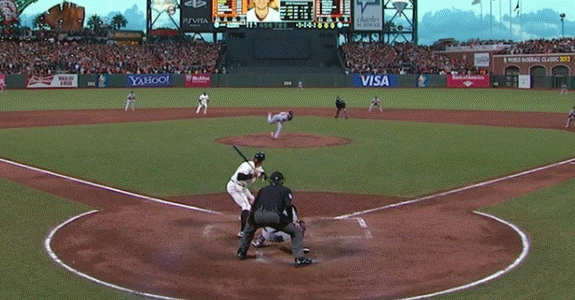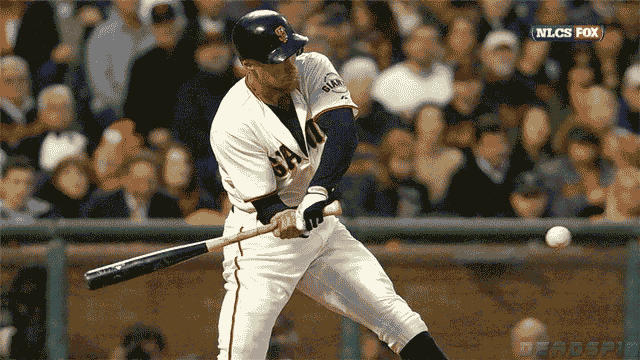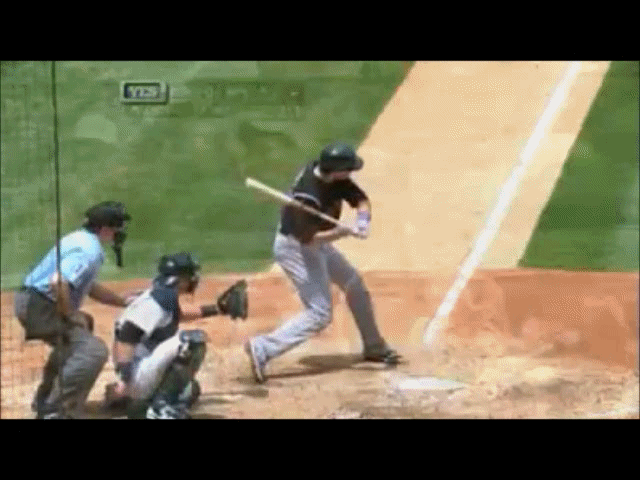An Analysis of Hunter Pence's "Triple Double"
Addendum 1, November 1, 2012
Addendum 2, November 14, 2012
Addendum 3, March 14, 2013
During Game 7 of the 2012 NLCS, October 22, 2012, Hunter Pence came to bat for the Giants with the bases loaded, nobody out, in the bottom of the third. He hit a grounder to the left side, normally a tailor-made double play. Now take a look at the two video clips shown below. In the first clip, we see a wide shot showing that the Cards shortstop Pete Kozma initially moved to his right, then recovered to move to his left but just out of reach of the ball. In the second clip, we see a high-speed video of the ball-bat impact, which is one of the most remarkable events I have ever seen. With the initial impact near the center of the bat, the bat breaks and the ball comes slowly off the bat. Meanwhile, the bat continues to rotate, catches up and impacts the ball a second and third time before the ball finally exits to the playing field with lots of sidespin on it. It is the sidespin that leads to the slicing action in the trajectory that takes it just out of the reach of Kozma. As you might imagine, there is a lot of physics contained in this play, and I want to explore some of it in this article. By the way, the bat impacted the ball three separate times and Pence reached 2B for a double, hence the "triple double".


So, let's try to pick apart what happened, highlighing what I consider the interesting physics. The ball hits initially off a region close to the center of the bat, where the vibrational amplitude for the lowest-frequency ("fundamental") vibrational mode is large. The resulting large-amplitude vibration breaks the bat. Note that the bat splinters toward the catcher, which is what is expected from the excitation of the fundamental mode. What happens to the ball? It seems to come off the bat quite slowly after the inital impact. The slowness really has little to do directly with the breaking of the bat. It mainly has to do with the fact the the efficiency of the ball-bat collision is low at that impact location. And it is low because the ball has lost a lot of energy that went into the vibrations of the bat. Of course, it is the vibration that ends up breaking the bat, but the post-collision speed of the ball would be low even if the bat did not break. I will return to this point later on. Under normal circumstances, the batted ball would have been a weakly hit ball to the left side. In any case, the ball comes off the bat slowly.
Meanwhile, because of momentum conservation, the bat slows down considerably after the initial impact but continues to move forward. The post-impact speed of the bat at the initial impact point is a little bit smaller than the speed of the ball. However, the barrel of the bat is moving faster than the initial impact point, although its motion is fairly complicated, since it is both rotating and vibrating. The barrel eventually catches up with the ball (remember, the ball is moving slowly) and impacts it a second time. After the 2nd impact, the ball and bat seem to be moving together, with the ball rolling along the surface of the bat toward the barrel tip. Because the barrel is continuing to vibrate, the ball and bat lose contact, then reconnect again at the barrel tip for a third and final impact.
During the rolling phase, the ball is not rotating very rapidly. However, the third impulse transfers both forward and sideways momentum to the ball. The forward impulse propels the ball away from the bat and into the left side of the playing field. The sideways impulse imparts sidespin to the ball. The sense of the sidespin is such that the trajectory of the ball slices toward 2B.
Let's turn the discussion to Pete Kozma. As you see from the wide-angle clip, Pete initially leaned to his right and even moved his right foot to the right before the ball had left the bat. When the ball was already in the air, you can clearly see that he took a jump step to his right. Then he realized where the ball was heading and dived back to his left, glove outreached but just out of range of the ball. The question I would like to address is, why did he initially move in the wrong direction. Realizing that what I am about to say is pure speculation on my part, here goes.
It is possible that Kozma saw that the ball was going to hit off the center of the bat, which typically happens for an inside pitch. According to the PITCHf/x data from Brooksbaseball.net, the pitch was a sinkerball that crossed the front plane of home plate 2.2 ft off the ground and hugging the inside corner of the plate. It could very well be the case that Kozma expected such a pitch to be hit to his right, based on years of experience dealing with such plays. So his natural instinct was to move in that direction in anticipation, even before contact was made. In an interview after the game, Kozma remarked: "It was going to go in the hole, and it ended up going up the middle. The ball was like a little banana. The ball kind of peeled, like he sliced it. I reacted one way and it’s tough to change directions like that. I had no chance at it." Now the quote reveals yet another reason for Kozma's initial reaction: "The ball was like a little banana." I suppose that is another way of saying that when the ball left the bat--not the initial impact but the final one--it started out moving to Kozma's right, then swerved sharply to his left. It is difficult to tell from the video if that is what really happened. What is safe to say is that a slicing ball hit to the shortstop hole is not the norm. What is normal is for the ball to either not curve at all (i.e., no sidespin) or to curve in the opposite direction. We have all see line drives swerve toward the foul pole. But due to the odd way that the ball interacted with the bat, especially during its last encounter, the ball was spinning in the opposite direction, leading to a slice rather than a hook.
Finally, let me return to the point I made earlier that the fact of the broken bat probably did not play an important role in the ultimate fate of the ball. A very similar event occured during the 2011 season when the Rockies Troy Tulowitski had a hit that was eerily similar to that of Pence, as shown in the clip below. In the Tulo case, the ball hit off the center of the bat resulting in a very low batted ball speed. The barrel of the bat caught up with the ball, resulting in a second impact off the end of the bat. The collision looks remarkably similar to that of Pence--except that the bat didn't break. It sort of makes you wonder whether multiple impacts happen more often that we suspect. After all, it takes high-speed video technology to know that it has happened, and such technology, while certainly not new, is new to the ballpark. Once again this shows that the closer we watch, the more we learn.

Troy Tulowitski's "Double Single" from 2011.
I close this article by remarking that the data exist for analyzing the trajectory of Pence's batted ball. Sportvision has so-called FIELDf/x cameras set up at AT&T Park and a full record of the flight of the ball and the movement of the fielder exists. If I am able to obtain these data, I will analyze and update this article at that time.
ADDENDUM 1
In light of some new information, let me return to the discussion I posed earlier as to why Kozma initially started moving in the wrong direction. The new information is the HITf/x data, provided to me from a "Deep Throat" source who prefers to remain anonymous. HITf/x is an enhancement to Sportvision's PITCHf/x system for tracking the pitched baseball and provides information about the initial trajectory of the batted ball. For the Pence hit, the initial batted ball speed was 76.8 mph, the vertical launch angle was 10.3o, and the horizontal spray angle was 19.0o to the left of the home plate-2B line. Using that information and the camera images from the first clip on this page, it is possible to address my question. To do so requires a calibration of the camera (i.e., its location, its orientation, and its zoom factor). This information can be roughly obtained using some known locations on the field, including the corner of home plate and the location of the three bases. Once the camera is calibrated, one can compare the landing point with the initial trajectory. This is done in the following set of images.

The three images are in time sequence from top to bottom. The red dot is the position of the ball in each image. The yellow line replicates a line drawn at ground level starting at the corner of home plate and oriented in the same direction as the initial trajectory of the ball, namely 19.0o to the left of 2B. If the ball continued on that initial trajectory, it would land somewhere on that line. The top image is the first one in the sequence where the ball is visible. The bottom image occurs just as the ball hits the ground. The middle image occurs at some intermediate time.
In the top image, Kozma is still at his pre-impact location. You can see that the initial trajectory of the ball would take it to his right. In fact, the initial trajectory of the ball passes through his right foot. Accordingly, he moves to his right, as you can see in the middle image. At that intermediate location, the initial trajectory of the ball passes through his left foot. In the bottom image, you can see that Kozma is now lunging back towards his left as the ball scoots by him. In fact, the ball that started out at 19o to the left of 2B ends up hitting the ground 17o to the left of 2B, which corresponds to about 4 ft of break. That is, the landing point of the ball is 4 ft to Kozma's left of where it would have landed if it continued on its initial trajectory. As if that is not bad enough, things are even worse than that, as I will now discuss with the aid of the next figure.
Thanks to another anonymous source, I have access to TrackMan data from several MLB games. TrackMan is a phased-array Doppler radar system that is used to track both the pitched and the batted ball. Although TrackMan was not set up for the game in question, I have used TrackMan data from other games to draw some general conclusions about the size and direction of the "break" of a line drive. The figure shows the final versus the initial horizontal spray angle for line drives hit by right-handed batters with a landing point between 50 and 120 ft from home plate. Each blue dot represents a batted ball satisifying these conditions. Positive and negative numbers correspond to the right and left side of 2B, respectively. The red line is the result one would obtain if the final and initial spray angles are equal. Note that for balls hit on the left side, the dots are all below the red line. That means that the final angle is always more negative than the initial angle, meaning that the ball curves away from 2B. For a ball hit at 19o to the left of 2B (-19 on the plot), the average amount of break is about 2o to the left. The actual break was 2o to the right. Just to make this point crystal clear, if the Pence hit were plotted on the same graph, it would have been a dot that is above the red line by about 2o. Although Kozma may not know the precise numbers, he certainly does know that the ball would break in that direction. He expected the ball to land at least 21o to the left of 2B, whereas it actually landed 17o to the left of 2B. So, he was actually off in his initial estimate by 4o, or about 8 ft. The sidespin on the ball, which is the reason for the break, was in the opposite sense from the usual direction. Almost surely that is the result of the unusual circumstances of the impact, with the third and final impact imparting a "slicing" rather than the usual "hooking" sidespin to the ball.
ADDENDUM 2
I have done some additional analysis and now have a reasonble scenario for the trajectory of the batted ball. Given the initial velocity vector and impact point from HITf/x, I simply adjust the two spin components to reproduce the landing point obtained from analysis of the video. The result is that the batted ball has 560 rpm of sidespin causing it to slice and 200 rpm of topspin. The fact that there is topspin makes the ball drop more quickly. In fact, if you look very carefully at the slo-mo clip of the impact, you can see that the ball comes off the bat after the final impact with topspin. Given the full initial conditions, I can now show how the trajectory would look from the same wide-angle camera view as that of the previous images.
In this image, the bases are the green squares and are connected with straight lines. The red curve is the way the trajectory would look in the camera, where I have taken care to make the aspect ratio approximately the same as in the camera image. The blue curve is the trajectory that the ball would have followed if it had 560 rpm of hooking sidespin, i.e., the opposite sense to what actually happened. The dashed line is the projection of the initial velocity at ground level (equivalent to the yellow line in the previous pictures) and shows where the ball would have ended up with no sidespin. The black diamond shows the location of Kozma's left foot just as the ball left the bat.
In conclusion, I think we now have a reasonable scenario for what happened in that highly unusual play. It is quite satisfying to look at a complicated play such as this one and say that you have a basic understanding about what actually occurred and why. That satisfaction goes to the heart of my enthusiasm for the physics of baseball.
ADDENDUM 3
I did one final piece of analysis for my talk at the 2013 SABR Analytics Conference, as shown in the figure below:



